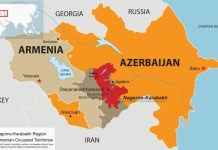Nepal’s geopolitical stance and geographical position i.e. being a landlocked country has made it dependent on either India or China. EurAsian Times brings you an analysis by Geopolitics on Chinese presence in Nepal and how India seems to be countering it.
Indian Air Force Activates Forward Airbase Near Chinese Border
India has exerted pressure on the Nepal Communist Party to address several issues such that pertain to the prejudice against the Madhesis who are of Indian-origin. India-Nepal ties and the bilateral relations have seen its highs and lows through the last decade.
While India has its roots in Nepal through cultural ties and soft power, China has been aggressively building ties with Kathmandu through economic diplomacy.
As a result of the economic blockade between India and Nepal in 2015, Kathmandu turned to China to seek help in meeting its energy demands. Quick to grab the chance, Beijing provided 33 per cent of the country’s fuel requirements, also allowing Nepal to use four of its seaports and three land ports.
To challenge Chinese dominance in the region, South Asia’s first-ever transnational oil pipeline was launched not more than a month ago from India’s Motihari district in Bihar to Amlekhgunj in Nepal.
Nepal recently called off an IIFA award ceremony citing “economic constraints on the treasury” and also has been working on a law which restricts the release of Bollywood movies while reserving the lions share for Nepali movies.
India’s ambitious pitch of BIMSTEC too saw resistance from Nepal when Kathmandu told its forces to skip the first Indo-Nepali military drill as a part of BIMSTEC.
Moreover, Beijing has tempted Nepal’s private schools to offer Mandarin as a language in exchange for the Chinese paying the salaries of teachers in those schools. This coincides with China’s ambitious Belt and Road Initiative in Nepal. China is aggressively building various infrastructure projects in Nepal like the new airport in Pokhara or a Himalayan railway line that plans to connect Kathmandu to Lhasa.
India’s soft power influence in Nepal has always remained a challenge to pro-China forces in Kathmandu and Beijing. Bollywood’s connect with the Millenials in Nepal is remarkable. More often than not, it immerses itself in discomfort manifested by the Nepali nationalists. CK Raut, the leader of the free Madhes movement in the Tarai region is said to be influenced by Hrithik Roshan. A PhD from Cambridge, Raut has been facing sedition charges in Nepal for demanding independence from the country.
The situation worsened when India signalled its desire to make changes in the Constitution newly drafted in Kathmandu. The Madhesis and other tribes of the Indian-origin failed to receive their due in the new draft. In a news report, it has been mentioned that leaders from political parties such as the Rashtriya Prajatantra Party (RPP) and Nepali Congress (NC) have openly stated that China has been fueling the anti-India protests for years now. Academia, film industry, media in Nepal is now influenced by China. The recent imposition of Mandarin in schools stands as a shining example of Chinese hegemony in Nepal.
In September 2018, Kurshid Alam Ansari, who was affiliated to the Indian Mujahideen (IM) was gunned down in Nepal. Shockingly, he was conferred martyrdom soon after. He was reported to have been awarded a membership with the Communist Party of Nepal (Maoist Center) (CPN-M). A request placed by India since a decade to extradite Ansari was taken lightly by the Nepalese authorities.
The largely unguarded border with Nepal has been taken by the Chinese and Pakistani intelligence to their advantage to smuggle arms, goods and carry out attacks in India and return to Nepal to seek shelter. Since the pressure on Pakistan to identify and eliminate terrorism originating in its backyard has surmounted in the past few years, Nepal has been used as a transit point for carrying out such attacks on Indian soil.
The Chinese are known to have the engineering prowess that can counter any challenges posed by geography and manpower. A new campus for the Nepal Armed Forces Police was inaugurated by the Chinese. The academy is located in Chandragiri, Kathmandu.
The Chinese are invested in ‘hard infrastructure’ that can help them boost connectivity to Nepal, in order to be able to counter India’s influence in the region. This includes railway lines, highways, bridges, airports, hydroelectric projects. A similar debt-trap is being laid across countries in South Asia. Unable to repay the loans on time, countries become “economic colonies” of China. Nepal-Tibet trade seems to be closer to reality ever since it has been shut since the Chinese invaded the territory in 1959. Optical fibre cable has been laid to create a virtual connectivity with the country.
The Kathmandu-Lhasa railway line will establish a solid physical connectivity too, allowing Kathmandu to be flooded with Chinese goods, destroying medium and small scale industries- both in Nepal and India. To help establish a cultural connect, the Chinese have taken undue advantage of the rising anti-India sentiments across Nepal.
India’s ability to complete infrastructure projects on time has remained dismal. The Chinese, on the other hand, are exceptional with their engineering marvel. The importance of hydroelectric projects in Nepal is humongous. China has been assisting Nepal in that field too, by allowing them to generate more hydropower than before.
Apart from investments and cultural influence, security concerns form a major part of the threat perception in Nepal and India is as much invested in the matter as the host country is. It is a known fact that the open border we share with Nepal has enabled smugglers, terrorists, criminals and militants over the years. Despite forces monitoring the border, the northern districts in Uttar Pradesh and Bihar frequently witnesses a number of arrests of individuals and groups associated with extremists in Pakistan.
The thick jungles in Nepal empowers the scope for cross border terrorism. The Inter-Services Intelligence (ISI) has increased its assets in Kathmandu over the years. Nepal has become a comfortable launch pad for the sleeper cells that aim to target India. Nepal has been a victim of this too. In the past, several Indian establishments in Nepal has been bombed.
The Pakistani Embassy in Nepal has allegations facing itself for funding Kashmiri and Sikh militants and providing them assistance by granting fake passports to enter India. The issue of counterfeit currency in India can be traced back to Nepal. Madrassas in Nepal are regularly funded, extremism is encouraged and people are more often than not misguided due to this issue.
The Nepalese are now starting to voice out the subservient attitude displayed by the Chinese towards them. Chinese nationals have been involved in human trafficking, cyber crimes and have gotten scotfree by paying a fine of ignorable amount. One shouldn’t be mistaken that the protests over land disputes exist only with India. Just a month ago, Xi Jingping’s effigies were burned in the streets after a border dispute with the Chinese emerged.
Several Indian-backed establishments are being systematically targeted by the Maoists led by the Biplav Group, which has been mentioned as a terror outfit by the United States. Change in New Delhi’s attitude is required in order to pursue our diplomacy in Nepal. Projects need clearances, funding at a pace that can be matched up to the Chinese.
Via: The Geopolitics, By Sharan KA: Views Personel





